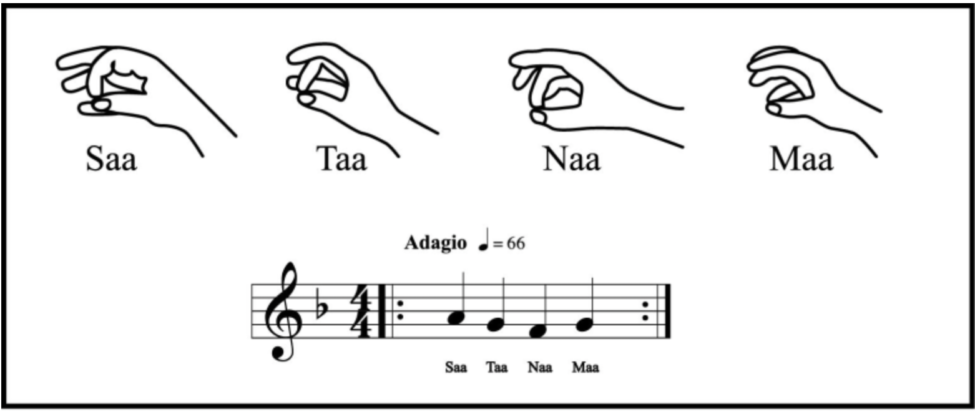
Kirtan Kriya is a powerful yogic meditation that offers numerous cognitive and mental health benefits. This simple yet effective practice combines mantra, mudra, and visualization to enhance brain function, reduce stress, and promote overall well-being.
“Ancient yogis did not have imaging or blood tests to unravel the biochemical changes created by Kirtan Kriya (KK) and other yoga exercises, but modern science has shown that practicing KK reduces stress levels and increases blood flow to parts of the brain that are central to memory and brain function.” Khalsa DS, Perry G. The Four Pillars of Alzheimer’s Prevention. Cerebrum. 2017 Mar 1;2017:cer-03-17. PMID: 28698774; PMCID: PMC5501038.
I’ll never forget the transformative journey I embarked upon during my Kundalini Yoga certification. One of the most profound practices I encountered was Kirtan Kriya. For 40 consecutive days, I immersed myself in the 31-minute version of this chanting meditation. The experience was nothing short of transformative. But here’s the kicker: recent research suggests that dedicating just 12 minutes a day to Kirtan Kriya can lead to an increase in the size of the hippocampus, a region of the brain crucial for memory. Think about that! Just 12 minutes daily can have such a profound impact on our brain’s health. Needless to say, I was utterly hooked on Kundalini Yoga.
Alzheimer’s disease, an unsettling neurodegenerative condition, is making its presence felt more than ever, especially among the Boomer generation. While many in this age group are vibrant and active, they’re beginning to confront the challenges of memory loss and cognitive decline. Lifestyle choices, including diet and exercise, play a pivotal role in brain health. While discussions on these topics are undeniably important, they’re beyond the scope of this piece. For a deeper dive into holistic approaches to cognitive wellness, I recommend exploring “The Four Pillars of Alzheimer’s Prevention” (Khalsa DS, Perry G. The Four Pillars of Alzheimer’s Prevention. Cerebrum. 2017 Mar 1;2017:cer-03-17. PMID: 28698774; PMCID: PMC5501038.)
Enter Kirtan Kriya. This ancient practice, deeply rooted in Kundalini Yoga, offers a beacon of hope. It’s not just about chanting or meditation; it’s a commitment to a lifestyle that champions brain longevity and spiritual well-being. The beauty of it? Even a short 12-minute daily practice can be a game-changer, enhancing cognitive function and potentially even reversing cognitive decline. In a world overshadowed by the looming threat of Alzheimer’s, Kirtan Kriya shines as a testament to the power of proactive aging.
Concluding remarks from Clinical Trial published in: “Kundalini Yoga Intervention Increases Hippocampal Volume in Older Adults: A Pilot Randomized Controlled Trial”
We examined the neurobiological effects of Kundalini yoga in a pilot neuroimaging RCT with healthy meditation-naïve older adults. We found a significant increase in volume of the right hippocampus after participation in the 12-week Kundalini yoga intervention, but not in the psychoeducation group. While preliminary, these findings encourage future full-scale trials to assess the potential of Kundalini yoga as a neuroprotective intervention.
Ibrahim M, Therriault J, Nair VP, Dikaios E, Rosa-Neto P, Walpola IC, Rej S, Lifshitz M. Kundalini Yoga Intervention Increases Hippocampal Volume in Older Adults: A Pilot Randomized Controlled Trial. Int J Yoga [serial online] 2022 [cited 2022 Sep 12];15:158-62. Available from: https://www.ijoy.org.in/text.asp?2022/15/2/158/355600
Before practicing Kirtan Kriya or any Kundalini yoga kriya or meditation, be sure to “Tune In” with the Adi Mantra.
What is Kirtan Kriya?
If you’ve ever delved into the world of Kundalini Yoga, you might have come across the term “Kirtan Kriya” (KK). Kirtan Kriya is a short yoga meditation technique with roots that trace back to ancient traditions.
But what exactly is it? At its core, Kirtan Kriya is a dynamic meditation practice that’s so much more than just chanting. Think of it as a multisensory experience that harmoniously blends various elements to produce profound healing effects on the mind and body, especially in the area of memory care.
Now, let’s break it down a bit. Kirtan Kriya isn’t just about chanting a mantra; it’s an intricate dance of breath, mudra (specific finger movements), mantra, and a unique visualization that traces the “golden chord” between your pineal and pituitary glands. Each component plays a pivotal role, and when combined, they create a symphony of sensory stimulation. It’s this unique combination that makes Kirtan Kriya stand out and offers its wide array of benefits.
For those of you who are visual learners, imagine this: as you chant, your fingers move in a deliberate pattern, your breath syncs with the rhythm, and internally, your focus travels along that golden chord, connecting vital points within your brain. It’s akin to orchestrating a holistic experience where every movement is purposeful, every chant resonates deeply, and the inner gaze remains steadfast, illuminating the path of the meditation.
In essence, Kirtan Kriya is more than just a meditation; it’s a multisensory journey that taps into the depths of our cognitive and spiritual realms, offering a transformative experience that’s both grounding and enlightening.

Why Practice Kirtan Kriya?
The power of Kirtan Kriya lies in its multifaceted benefits. During my Kundalini Yoga teacher training in Vancouver BC, we were taught a profound lesson: if one were to be stranded on a desert island and could only take one or two meditations with them, Kirtan Kriya would undoubtedly be on that list. Such is its potency.
Beyond personal anecdotes, there’s a growing body of scientific evidence emphasizing the significance of lifestyle choices and psychological well-being in the prevention of Alzheimer’s. Literature references are given below. Lifestyle and mental well-being play an increasingly recognized role in warding off Alzheimer’s, with research underscoring their critical importance in disease prevention. The harmonious function of the brain, as facilitated by KK, creates an optimal healing environment. This balance energizes the nervous system, stimulates circulation, and promotes psychological well-being, crucial for Alzheimer’s prevention.
“According to clinical psychologist and yoga therapist Chris Walling, doing 12 minutes daily of the Kundalini Yoga practice known as Kirtan Kriya is proven to enhance brain and mental health, increase longevity, and keep your mind sharp.”
Kripalu: Center for Yoga and Health
What Research Has Shown
Chronic stress, a significant risk factor for Alzheimer’s disease, has detrimental effects on our genes, leading to unhealthy expressions like inflammation, a hallmark of Alzheimer’s. The fast-paced world we live in only amplifies this stress. However, Kirtan Kriya offers a respite. Over the past decade, research has illuminated the brain-boosting benefits of this 12-minute yoga/meditation technique. Studies have shown that KK not only reduces stress levels but also enhances blood flow to critical brain regions, such as the anterior cingulate gyrus (ACG) and the prefrontal cortex (PFC), both vital for memory and cognitive function. Furthermore, KK has been found to reverse memory loss, reduce anxiety, and even increase the enzyme telomerase by a staggering 43%, the highest ever recorded. This enzyme plays a crucial role in elongating the DNA protective cap, the telomere, essential for a sharp mind and long life.
What are the Benefits of Kirtan Kriya
- Improved Sleep: KK has been shown to enhance sleep quality, ensuring you wake up refreshed.
- Mood Enhancement: Regular practice can uplift your mood, keeping those blues at bay.
- Decreased Depression: KK acts as a natural antidepressant without any side effects.
- Reduced Anxiety: It helps in calming the mind, and reducing anxiety levels.
- Regulation of Genes: KK helps in downregulating inflammatory genes and upregulating immune system genes.
- Improved Insulin and Glucose Regulation: It plays a role in maintaining blood sugar levels.
- Increased Telomerase: A 43% increase in telomerase has been observed, the highest ever recorded.
- Enhanced Psycho-Spiritual Well-Being: KK not only benefits the body but also the spirit, emphasizing the importance of spiritual fitness in cognitive function and Alzheimer’s prevention.
How Does Kirtan Kriya Work?
The brain’s two hemispheres are intricately connected by the corpus callosum, with additional connections from the limbic system and hypothalamus. Kirtan Kriya, through its repetitive chanting, synchronized breathing, and patterned movements, stimulates these connections, promoting optimal brain function. This synchronization fosters a healing environment, harmonizing the mind, body, and spirit. As a result, the endocrine system finds its balance, the nervous system is rejuvenated, and circulation gets a boost, all of which are essential for cognitive wellness.
Further Reading
- Effects of Meditation versus Music Listening on Perceived Stress, Mood, Sleep, and Quality of Life in Adults with Early Memory Loss: A Pilot Randomized Controlled Trial
- Incredible Power of Kirtan Kriya: A Conversation on Brain Health and Longevity with Dr. Chris Walling
- Kundalini Yoga
- The Alzheimer’s Research and Prevention Foundation
- The Incredible Power of Kirtan Kriya Meditation
- Yoga and Kirtan Kriya Meditation Bolster Brain Functioning Over Time
Please note that these references are provided for further exploration and do not constitute an endorsement of any particular viewpoint or information contained within. Always consult with a healthcare professional or trusted source when making decisions related to health and well-being.
FREE PDF GUIDE TO KIRTAN KRIYA
Disclaimer:
The information provided in this article is for educational purposes only and is not intended to diagnose, treat, cure, or prevent any disease or health condition. It does not constitute medical advice or replace professional consultations with a qualified healthcare or medical professional. Always seek the advice of your physician or another qualified health provider with any questions you may have regarding a medical condition. Never disregard professional medical advice or delay in seeking it because of something you have read in this article.
Interested in Kundalini Yoga and want to dive into a transformational process? Discover the Power of Kundalini Yoga.
Join us for live streaming classes led by Anne Taylor, Ph.D.

This article on Kirtan Kriya and its potential as a natural approach to Alzheimer’s prevention is both enlightening and inspiring. Dr. Anne Taylor’s exploration of this powerful yogic meditation technique sheds light on its multifaceted benefits and its capacity to positively impact cognitive and mental health.
What’s particularly fascinating about Kirtan Kriya is its holistic approach. It combines various elements, including mantra, mudra, and visualization, creating a multisensory experience that promotes profound healing effects on both the mind and body. The detailed description of how Kirtan Kriya works, including its impact on brain function and overall well-being, underscores its potential as a valuable tool in cognitive wellness.
Thank you for sharing this article.
Hi Demi,
Thank you so much for your thoughtful insights on the article. I’m genuinely pleased to hear that you found the exploration of Kirtan Kriya enlightening. It’s indeed a powerful meditation technique that offers a holistic approach to cognitive and mental health. Your emphasis on its multisensory experience and profound healing effects resonates deeply with the core message I aimed to convey. I wholeheartedly agree that Kirtan Kriya is a valuable, yet freely accessible, tool for cognitive wellness. I’m grateful for readers like you who engage deeply with the content and share their perspectives. Let’s continue to spread the word about such transformative practices.
Warm regards, Anne